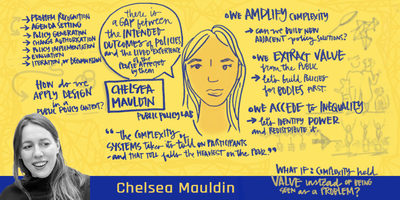Policy Design & Decision Making
Mauldin, Chelsea (2018) Policy Design & Decision Making. In: Proceedings of RSD7, Relating Systems Thinking and Design 7, 23-26 Oct 2018, Turin, Italy.
![Mauldin_Policy_2018.jpg [thumbnail of Mauldin_Policy_2018.jpg]](https://openresearch.ocadu.ca/2673/1.hassmallThumbnailVersion/Mauldin_Policy_2018.jpg)  Preview |
Image
Mauldin_Policy_2018.jpg Download (196kB) | Preview |
Abstract
There’s a gap between the intended outcomes of policies and the lived experiences of people affected by those policies. This gap arises, in part, from differences in the decision-making of policymakers and members of the public. Policymakers are empowered – they control public resources and have a mandate to deliver services. Their professional training and the culture of government tends to be progress-minded, rational, and technocratic.
Meanwhile, the public they serve is often disempowered – by class, race, neighborhood, or life circumstance. Even privileged citizens often have limited engagement with government decision-making. Further, members of the public approach policy issues pragmatically, informed by both their cognitive load and their biological experience – both factors that policy is often loath to engage.
I’ll discuss how designers attempt to bridge this gap though interventions in the policy decision-making cycle – from preliminary problem recognition and agenda setting to policy implementation and evaluation – with specific reference to Public Policy Lab’s work with veterans dealing with mental-health issues, with low-income families seeking social services, and with applicants to social/affordable housing.
Next I’ll describe shortfalls of current design interventions in policy and service-delivery systems. First, designers often amplify complexity – but complexity burdens the poor, who have fewer resources to spend navigating it. Second, designers seek to reform the state’s engagement with the public, but replicate the state’s extractive posture: we collect peoples’ stories, harvest their life experiences for our gain, even engage them in co-design, where their labor becomes our deliverable. Third, by working inside systems, designers accept status quo inequality. At our best, we engage in meaningful research and design with marginalized peoples. But collaboration does not compensate for systemic racism and poverty.
To conclude, I’ll propose that designers engaged in policy and systems change design new, adjacent policy systems, rather than to continue to renovate broken policies; recognize the primacy and requirements of the human body, as mechanism through which people engage with and are affected by policy systems; and more consciously identify and address imbalances in power in the systems in which we intercede.
| Item Type: | Conference/Workshop Item (Keynote) |
|---|---|
| Date Deposited: | 19 Jun 2019 14:42 |
| Last Modified: | 02 Aug 2021 08:46 |
| URI: | https://openresearch.ocadu.ca/id/eprint/2673 |
Actions (login required)
 |
Edit View |

 Tools
Tools Tools
Tools